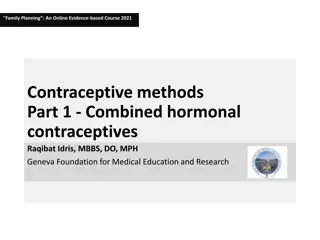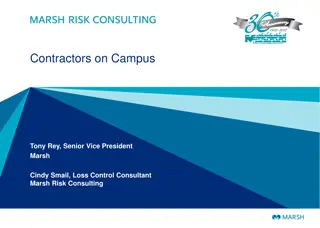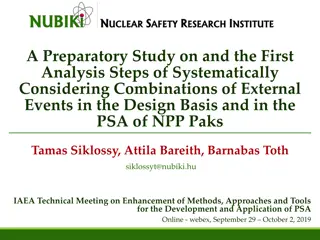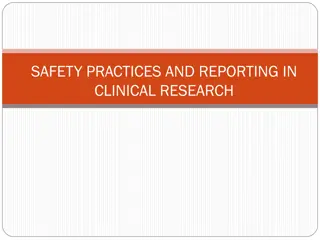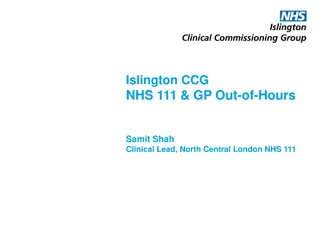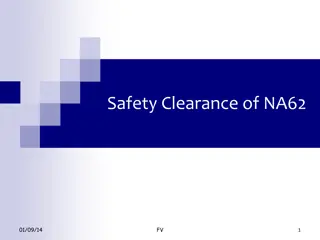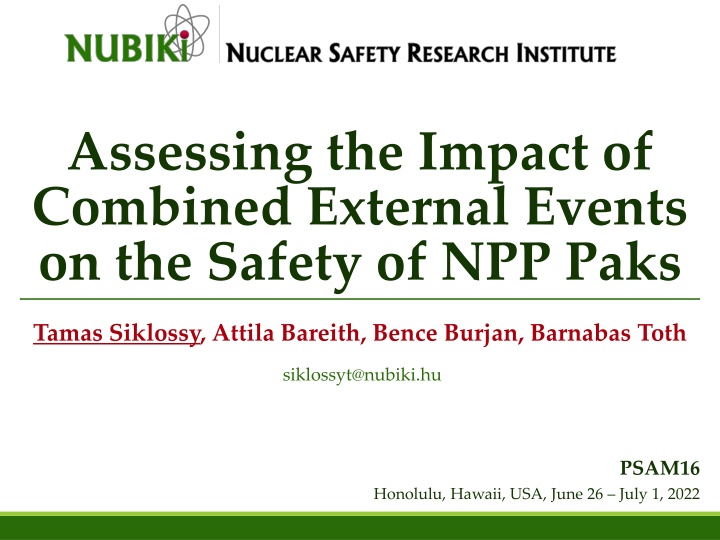
Impact of Combined External Events on NPP Safety at Paks
Assessment of hazard combinations on nuclear power plant safety, focusing on the Paks NPP in Hungary. Examining external hazards, risk quantification, safety concerns, and analysis steps for addressing potential threats to plant safety.
Download Presentation

Please find below an Image/Link to download the presentation.
The content on the website is provided AS IS for your information and personal use only. It may not be sold, licensed, or shared on other websites without obtaining consent from the author. If you encounter any issues during the download, it is possible that the publisher has removed the file from their server.
You are allowed to download the files provided on this website for personal or commercial use, subject to the condition that they are used lawfully. All files are the property of their respective owners.
The content on the website is provided AS IS for your information and personal use only. It may not be sold, licensed, or shared on other websites without obtaining consent from the author.
E N D
Presentation Transcript
Assessing the Impact of Combined External Events on the Safety of NPP Paks Tamas Siklossy, Attila Bareith, Bence Burjan, Barnabas Toth siklossyt@nubiki.hu PSAM16 Honolulu, Hawaii, USA, June 26 July 1, 2022
Content Introduction Objectives Types of External Hazard Combinations Major Analysis Steps Findings Conclusions 3/12/2025 Assessing the Impact of Combined External Events on the Safety of NPP Paks 2
Introduction Mostly single external hazards were considered in the definition of the design basis for the Paks NPP in Hungary Motivation of assessing the impact of hazard combinations on NPP safety Hungarian Nuclear Safety Codes and international recommendations Lessons learnt from the Fukusima Dai-ichi accident Finding of the Periodic Safety Review of the Paks NPP in 2017 Preparatory study in 2018: the regulations and recommendations have been looked at the available methodologies have been studied and evaluated analysis practices applied in Hungary have been reviewed a proposal has been developed for the technical tasks and the schedule thereof to identify combinations of external hazards and assess the effects of such hazards on NPP safety (including high level methodology of each analysis steps) 3/12/2025 Assessing the Impact of Combined External Events on the Safety of NPP Paks 3
Objectives Identify combinations of external hazards and assess the effects of such combinations on NPP safety identification and characterization of load combinations assess the effects of hazard combinations on NPP safety: justification of the adequacy of protection against hazard combinations to be included in the design basis quantification of the residual risk due to beyond design basis load combinations and identification of the main risk contributors Identify important safety concerns Transients in full power operation and in LPSD states 3/12/2025 Assessing the Impact of Combined External Events on the Safety of NPP Paks 4
Types of Combined External Hazards Combination of dependent hazards causal connection Consequential hazards cause-effect relation: A may cause B (e.g. explosion forest fire) A is a prerequisite of B (e.g. earthquake soil liquefaction) Non-consequential connected hazards (correlated hazards) common root cause (e.g. a meteorological condition triggers many hazards) Combination of independent hazards (coincidental hazards) no causal connection independent events have a high occurrence frequency, at least one of the events is long-lasting and usually rare. 3/12/2025 Assessing the Impact of Combined External Events on the Safety of NPP Paks 5
Major Analysis Steps PSA: I. II. III. Detailed assessment of screened-in event combinations: i. Hazard assessment ii. Plant response and fragility analysis iii. Event logic modeling and risk quantification Selection of combined external hazards Screening of combined external hazards Design basis (identification and justification of protection): I. Selection of combined external hazards II. Screening of combined external hazards III. Definition of design basis load combinations IV. Evaluation of plant protection and specification of protective measures 3/12/2025 Assessing the Impact of Combined External Events on the Safety of NPP Paks 6
Selection of Combined External Hazards Development of a comprehensive list of potential single external hazards Screening of single hazards with respect to hazard combinations screening by relevance (cannot occur at the site) frequency based screening (10-7/a for Paks NPP) Evaluation of the dependence among the hazards a table ( matrix ) form cross-correlation chart for all the possible hazard combinations, the possible relation type has to be identified and marked with a predefined symbol identification of hazard combinations including 3 or more hazards: mapping of root causes that may trigger such combinations studying the dependence in rows and columns of the cross-corr. chart 3/12/2025 Assessing the Impact of Combined External Events on the Safety of NPP Paks 7
3/12/2025 Assessing the Impact of Combined External Events on the Safety of NPP Paks 8
Selection of Combined External Hazards Possible relation types one hazard is a prerequisite of the other hazard one hazard may cause the other hazard, the impact mechanisms of the single hazards are similar or the same one hazard may cause the other hazard, the impact mechanisms of the single hazards are different correlated hazards, the impact mechanisms of the single hazards are similar or the same correlated hazards, the impact mechanisms of the single hazards are different independent hazards, the impact mechanisms of the single hazards are similar or the same independent hazards, the impact mechanisms of the single hazards are different mutually exclusive hazards 3/12/2025 Assessing the Impact of Combined External Events on the Safety of NPP Paks 9
Screening of Combined External Hazards 666 hazard combinations were mapped, consisting of 2 hazards In general, the same screening criteria as for single hazards Relation between the impact mechanisms of the single hazards: similar or the same (e.g. wind & snow to structures): hazards affect the same SSCs amplifying one another s effects resistance against the combined load has to be assessed different (e.g. wind & high temperature) hazards do not affect the same SSCs or not with the same mechanisms Hazard combination specific screening criteria: hazards are mutually exclusive definition of a single hazard covers the other single hazard the impact of the hazard combination is not more severe than the effect of the more powerful hazard 3/12/2025 Assessing the Impact of Combined External Events on the Safety of NPP Paks 10
Screening of Combined External Hazards Detailed screening of hazard combinations was performed considering the following hazard categories: hydrological hazards; man-made external hazards; riverine events endangering the water intake facility; hazards related to the relevant areas of geosciences; meteorological hazards. For the sake of traceability and transparency screening not on a case-by-case basis, but looking at hazards within a group and then hazards related to different categories 3/12/2025 Assessing the Impact of Combined External Events on the Safety of NPP Paks 11
Screened-in Combined External Hazards handling of dangerous substances in severe weather conditions multiple accidents in nearby industrial facilities due to a common initiator of natural origin earthquake occurring when the ambient temperature is extreme (independent hazards) storm: high wind, extreme precipitation and thunder snowstorm and accumulated snow and strong wind: extreme wind and snow extreme warm weather: extremely high air temperature and high Danube temperature extreme cold weather: extremely low air temperature and surface ice on the Danube (and icing and snow) (geoscience related hazards, e.g. earthquake and soil liquefaction) (possible combinations of single hydrological events) (external hazards endangering the blockage of water intake from the river Danube combinations of single endangering events) 3/12/2025 Systematically Considering Combinations of External Events in the Design Basis and the PSA 12
Hazard Assessment Man Made Hazards A large number of dedicated deterministic analyses to determine the effects of an accident during handling dangerous substances in severe weather conditions -> do not pose more significant impact on the NPP safety than in moderate conditions screened out from further assessment Multiple accidents in nearby industrial facilities do not pose a significant challenge to the NPP safety due to the distance between the hazard sources and the NPP the direction of the sources relative to the NPP and the different types of effects of the various sources 3/12/2025 Assessing the Impact of Combined External Events on the Safety of NPP Paks 13
Hazard Assessment Natural Hazards Snowstorm: relative frequency of strong winds during intensive snowfalls Full correlation was conservatively assumed between the extreme (return) values of instantaneous, daily and weekly air temperatures, and cooling water temperature Earthquake occurring when the ambient temperature is extreme (independent hazards dedicated approach) ? = ? ?1 ?2 ?1+ ?2 ?? occurrence frequency of event i [1/a] ?? duration of event i [year] N duration (in a year) when both events may occur simultaneously [year] Storm; Accumulated snow and strong wind: collected site specific data joint distribution function bivariate extreme value distribution logistic dependence model extreme value distribution functions of single hazards as marginal distributions 3/12/2025 Assessing the Impact of Combined External Events on the Safety of NPP Paks 14
3/12/2025 Assessing the Impact of Combined External Events on the Safety of NPP Paks 15
Plant Response and Fragility Analysis Earthquake occurring when the ambient temperature is extreme: failure of the HVAC system induced by below design basis seismic events during moderately extreme air temperature the potential processes and the corresponding fragility curves plant is sufficiently protected against low air temperature Storm: LOOP induced by high wind or lightning and simultaneously extreme precipitation cooling water of diesel generators are discharged to the same canalization system that is used for rainwater discharge plant is sufficiently protected against such scenarios Extreme warm and cold weather plant response is almost the same to these events as to single hazards, not assessed further 3/12/2025 Assessing the Impact of Combined External Events on the Safety of NPP Paks 16
Plant Response and Fragility Analysis Accumulated snow and strong wind: thorough review of the already available structural analyses -> the fragilities assessed for single hazards are bounding some combinations were already considered dominant structural components in the fragilities do not coincide new scenario: LOOP (with wind fragility) during heavy snowfall Snowstorm conservative expert judgement the conditional blockage probability of the air intake system to the diesel generators in case of a heavy snowfall is 0.1 (if no operator action is assumed) 3/12/2025 Assessing the Impact of Combined External Events on the Safety of NPP Paks 17
Event Logic Modelling Earthquake occurring in extreme warm weather Identification of event sequences leading to core damage (seismic failures leading to loss of HVAC system) Single hazard fragility curves could be used in the assessment CCDP for extreme warm weather situations when HVAC is not available was estimated based on conservative expert judgement No detailed PSA model, spreadsheet application to determine cut set frequencies, overall CDF, perform sensitivity analysis Extreme wind and snow New events: wind induced loss of off-site power during extreme snowfall wind induced switchyard failures leading to LNPS during extreme snowfall loss of the diesel generators due to snowstorm (blockage of air intake systems) Scenarios: wind induced LOOP AND snow induced failure snow induced switchyard failures AND blockage of the air intake filters to the DGs Event tree for extreme snow was utilized, quantification similar to single hazards 3/12/2025 Assessing the Impact of Combined External Events on the Safety of NPP Paks 18
Findings Earthquake occurring in warm weather CDF 1.74 10-7/a same failures in full power operation and in LPSD (constant risk) considerable uncertainties, hence regarded as an upper bound fans and heat exchangers of the HVAC system and the seismically unqualified relays and cabinets are the dominant risk contributions Extreme wind and snow CDF 2.06 10-8/a Dominant event sequences: LOOP due to high wind and the blockage of the air intake system of the DGs wind induced failure of the switchyard, subsequent failure of plant operation in island mode and the blockage of the air intake system of the DGs limited scope of uncertainty assessment showed remarkable uncertainties Several safety enhancement measures were proposed 3/12/2025 Assessing the Impact of Combined External Events on the Safety of NPP Paks 19
Conclusions An assessment of combined external hazards for the Paks NPP has lately been completed. The relevant load combinations have been identified and characterized The adequacy of protection against hazard combinations has been justified. The residual risk due to beyond design basis load combinations has been quantified and the main risk contributors have been identified. The assessment followed the commonly exercised steps in this domain: hazard selection and screening, hazard assessment, evaluation of plant protection, plant response and fragility analysis, development of event sequence models for hazard initiated plant transients risk quantification and evaluation of results. The Paks NPP is sufficiently protected against the combined external hazards. 3/12/2025 Assessing the Impact of Combined External Events on the Safety of NPP Paks 20
Thank you for your attention!







